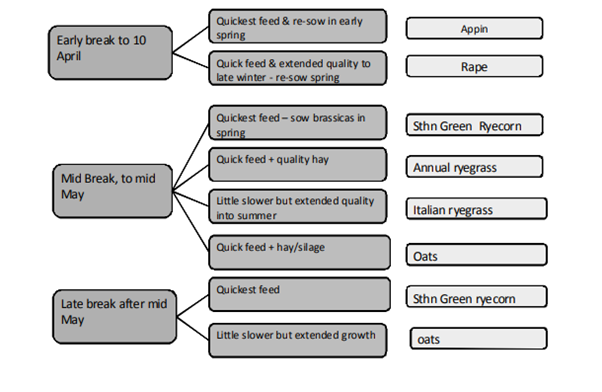What to sow for quick winter feed – reviewing Reg Hill’s article from 2011
Neil James, Agriculture Victoria, Ballarat
In 2011, renowned agronomist Reg Hill (then with PGG Wrightson Seeds), presented a paper at the 52nd Annual Conference of the Grassland Society of Southern Australia (GSSA), titled ‘What to sow for quick winter feed’.
Although 13 years have passed, many of the recommendations from this paper still ring true. Extracts from the paper have been shared (kindly, thanks to GSSA), with several comments regarding currency. The paper related to a series of experiments initiated by PGG Wrightson Seeds in 2007 to help farmers evaluate what they could sow to get the quickest possible winter feed.
Annual ryegrass sowing rate
Annual ryegrass (Winter Star II) was sown at 5 different sowing rates (10, 20, 30, 40 and 50 kg/ha) in 4 experiments over 3 years. Increasing the sowing rates from:
- 10 to 20 kg/ha increased winter feed supply by about 1000 kg DM/ha (Dry Matter)
- 20 to 30 kg/ha by about 700 kg DM/ha
- 30 to 40 kg/ha by about 500 kg DM/ha
- 40 to 50 kg/ ha by about 200 kg DM/ha.
Note that, ‘if 1 tonne of supplementary feed is worth about $150 and 10 kg of seed about $35, the economics stacked up well’. [Neil: Even with current prices, the economics still stack up – for example, if a tonne of supplementary feed is $350/tonne and 10 kg of seed is $40 to $45.]

Sowing times
In 2007, 26 treatments and 2 sowing times (11 April and 2 June) were established at the Ballarat research site. This included appin leafy turnip (which has no winter cold requirement); 4 rape varieties; Southern Green ryecorn; oats; triticale; annual ryegrass; Italian ryegrass and oats and annual ryegrass.
'The brassicas performed very well, but only when sown early. Appin leafy turnip was consistently the quickest brassica but bolted to seed after 2 or 3 grazings. [Neil: We now have some more winter active brassicas.] Nevertheless, if feed is critically short and an early break occurs it is a good option. Rapes do last an extra grazing or 2 but may have to be re-sown in spring unless sown with an Italian ryegrass which can extend growth into the spring/summer.’
‘Annual and Italian ryegrasses were good options if an early break occurred (i.e. early sown). They have quality advantages over the cereals and can extend the supply of quality feed into summer; however, if quick winter feed is the priority and the break is at all slow, they were not as good as cereal’s. [Neil – Very much still right.]
‘Fodder ryecorn performed well at any sowing time but was consistently the best treatment when sown mid-to-late season. If the break hasn’t arrived by mid-April and feed is desperately short, it was by far the quickest option. It will perform well in poor soils and during droughts.
However, its growth rate is, in part due to its lack of a winter cold requirement and after 2 or 3 grazing's, it will send up a seedhead and quality will decline rapidly.’ [Neil: Recent demonstrations have confirmed this and needs to be grazed hard to avoid bolting to a seed head, and stock avoiding it.]
‘Early grazing will delay bolting and enable 3 grazing's but if left until it’s 30 or 40 cm high and grazed hard by cattle, recovery will be very poor. Fodder ryecorn can be sown with ryegrass to extend the feed supply and quality into spring but in drought years this will reduce yields.
Oats remain an excellent option for later sowings. While they don’t have the speed of ryecorn, they do last longer and can provide useful hay or silage. If sowing 3 or 4 paddocks, an option may be to sow 1 paddock of ryecorn for the first grazing and 3 paddocks of oats. Deciding what to sow? All species tested have a role and the best choice will depend on when the autumn break occurs and when you need the feed.’
The following decision tree summarises Reg’s findings and are still relevant today although the varieties have changed.

Source: Reg Hill in Proceedings of the 52nd Annual Conference of the Grassland Society of Southern Australia Inc 2011
For more information contact Neil James, Agriculture Victoria.